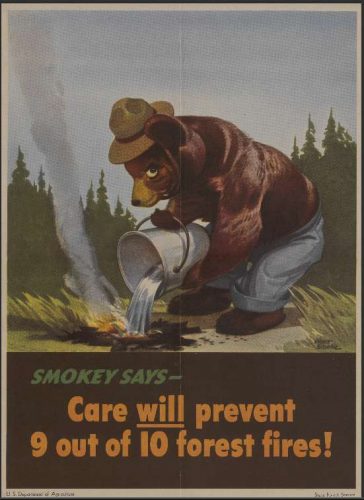Happy Birthday, Smokey Bear!


This year marks the 75th anniversary of the Smokey Bear Wildfire Prevention campaign, making it the longest-running public service advertising campaign in history. The friendly bear in blue jeans has taught children and adults alike about wildfire prevention, but not many know that Smokey Bear was originally a World War II civil defense effort. So how exactly did Smokey come to be?
In early 1942, a Japanese submarine surfaced near the California coast and shelled an oil field near the Los Padres National Forest. Although the attack failed to cause significant damage, it raised fears that enemy attacks might cause wildfires at a time when experienced firefighters were away at war. To reduce this risk, the U.S. Forest Service, the Association of State Foresters, and the War Advertising Council (also known as The Ad Council) joined together to create the Cooperative Forest Fire Prevention Program (CFFP).
The CFFP’s early posters linked fire prevention to winning the war, and featured slogans such as “Our Carelessness, Their Secret Weapon” and “Careless Matches Aid the Axis.” However, in August 1942, Walt Disney Productions released Bambi and allowed the movie’s characters to be used on a 1943 fire prevention poster. Although the success of the Bambi poster paved the way for using animal characters to promote fire prevention, Disney had only granted rights to use the characters for one year.
The CFFP needed a new symbol of their own. They experimented with squirrels, but instead decided to use a bear that could stand upright and demonstrate fire safety practices. In 1944 Smokey Bear made his first appearance on a poster (seen above), wearing blue jeans and a ranger hat and pouring a bucket of water on a campfire. The campaign worked, and Smokey’s popularity grew.

In 1950, firefighters battling a forest fire in New Mexico’s Capitan Mountains rescued a bear cub that had survived by climbing a tree, but suffered severe burns on his paws and hind legs. News about the little bear quickly spread throughout New Mexico and across the country. The U.S. Forest Service “adopted” the cub, who was named Smokey and sent to the National Zoo in Washington, D.C., as a living symbol of wildfire prevention.
Like his illustrated counterpart, the real-life Smokey became extremely popular, especially with children. He received so much mail—more than 13,000 letters per week—that in the 1960s he was given his own ZIP code (20252), which is still in use today. Smokey lived at the National Zoo until his death in 1976, and is buried at the Smokey Bear Historical Park in Capitan, New Mexico.
Over the course of the past 75 years, Smokey Bear has appeared in print, radio, and television ads and on stamps, t-shirts, and other merchandise. (Thanks to a 1952 Act of Congress that removed Smokey from the public domain, all licensing revenue is used for wildfire prevention education.) He has been featured in a radio play, songs, and even a biographical comic book. Most importantly, he has educated generations of children and adults about wildfire prevention.
This week, Smokey Bear wrapped up his year-long birthday celebration at the Lighting of the U.S. Capitol Christmas Tree in Washington, D.C. Here’s wishing him another 75 years!
Thank you to Stephanie Michaels, Research and Catalog Services Librarian at theState Library of Ohio, for this week’s post!



Leave a Reply
You must be logged in to post a comment.